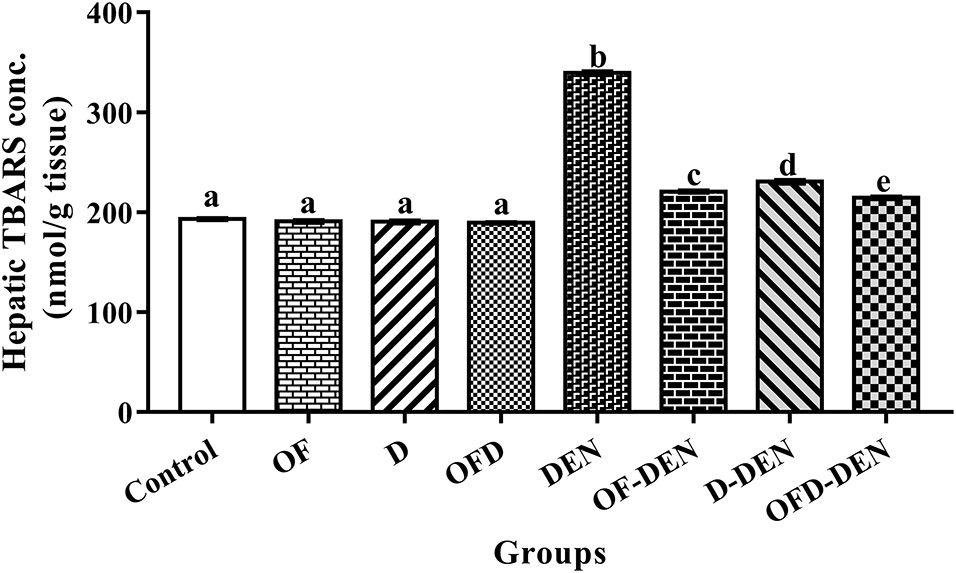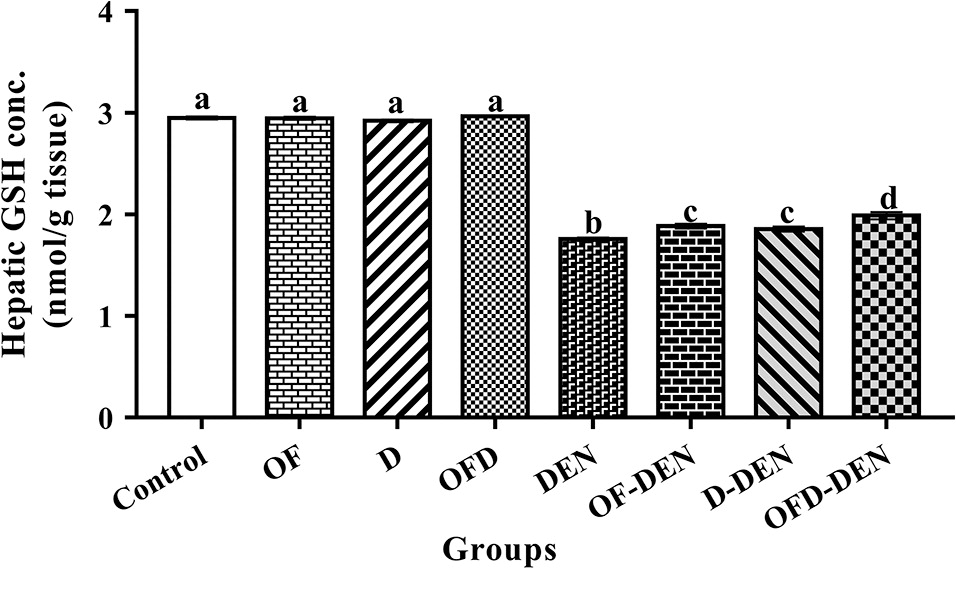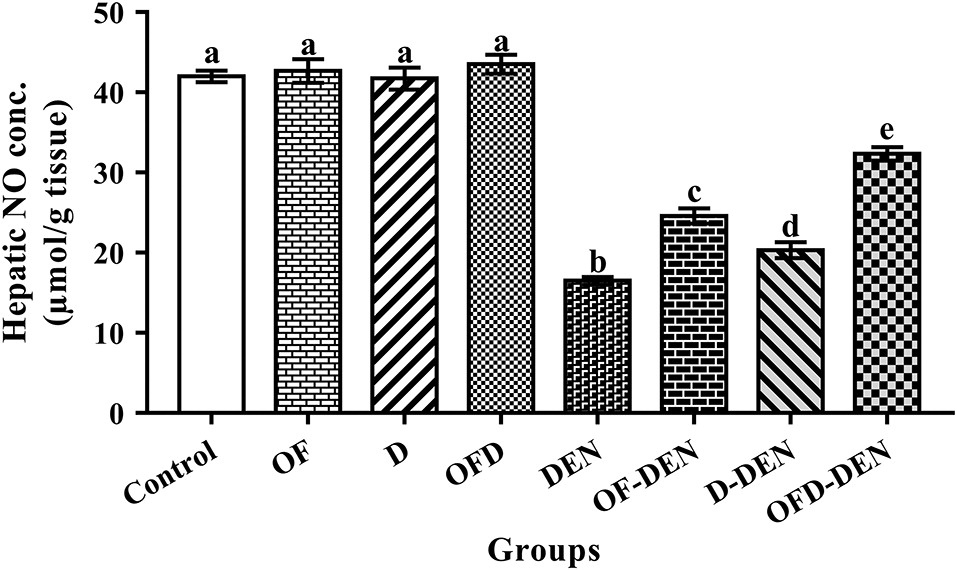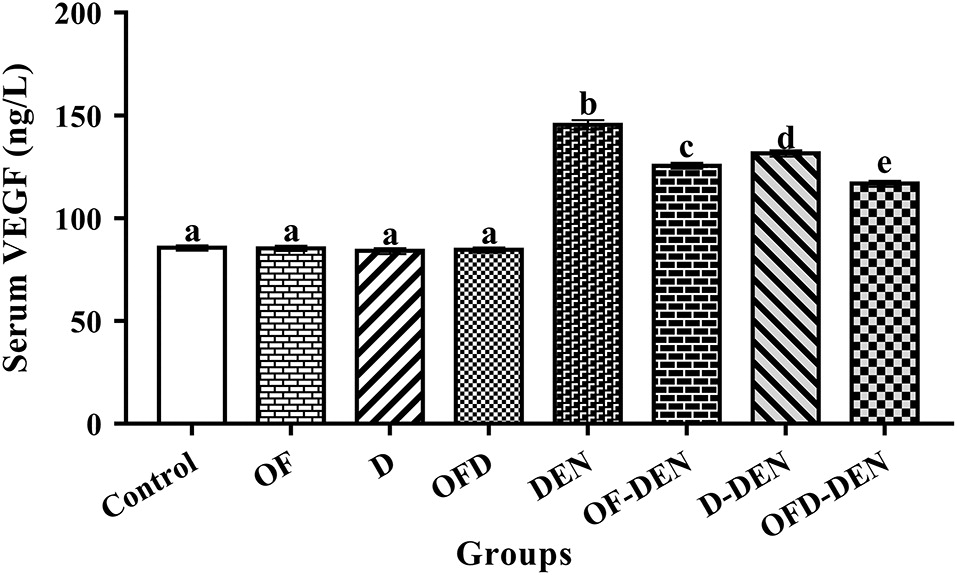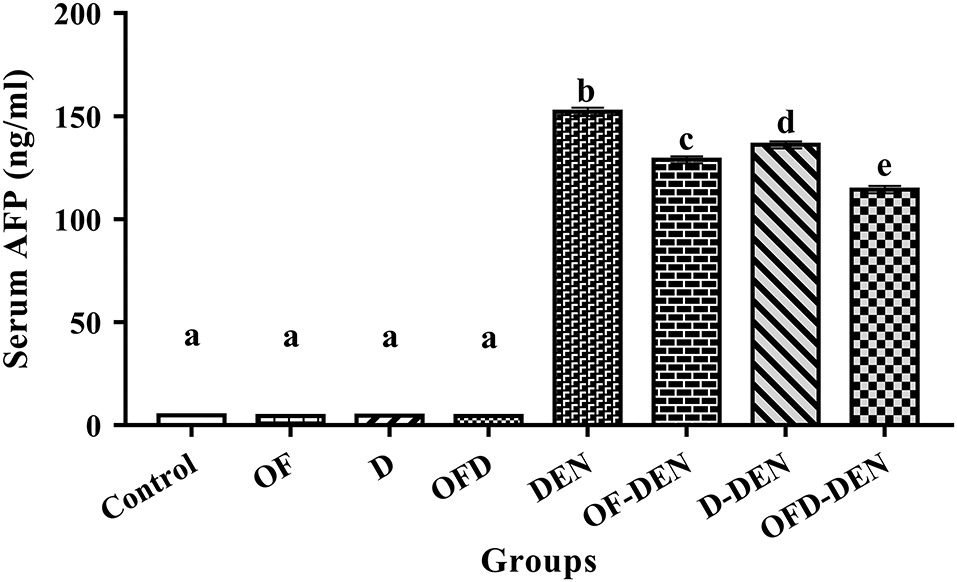Materials and methods
Chemicals
DEN was purchased from Sigma-Aldrich (St. Louis, Missouri, USA). DEN was given to rats in drinking water (100 mg/L). The DEN solution was prepared as a fresh solution every other day and provided to rats in dark bottles. Other chemicals were of high analytical grade and were purchased from standard suppliers.
Extra virgin olive oil (Olea europaea L., Family Oleaceae)
Monumental brand extra virgin olive oil was procured from the Grup Pons company (Lleida, Spain).
Fig fruit extract (Ficus carica L., Family Moraceae)
Dried ripe figs were procured from Kafoods Ltd. (Istanbul, Turkey). Fig fruit crude extract was prepared and lyophilized following the method of
Gilani et al. (2008).
Date palm fruit extract (Phoenix dactylifera L., Family Arecaceae)
Date palm fruit were purchased from the Al-Madina AL-Mubaraka market, Saudi Arabia. The plant material was cleaned of soil and the date palm fruits were separated from the pits. The flesh of the fruits was cut into small pieces, dried, and coarsely ground using an electrical device. Distilled water was added to coarsely pounded date palm fruit (3:1 ratio, weight to volume) for 48 h in a refrigerator (4 °C) with continuous stirring (
Al-Qarawi et al. 2005). The whole solution was ground and then centrifuged at 4 °C for 20 min at 1788
g. The supernatant was collected and stored at −20 °C until use (
Vayalil 2002).
The plant materials were identified and authenticated. Voucher specimens of the authenticated plant materials were deposited at the medicinal plants research station, Faculty of Pharmacy, Ain-Shams University, Cairo, Egypt.
Ethics statement
All animals in our study were handled in accordance with the ethical guidelines for investigations using laboratory animals and complied with the guide for the care and use of laboratory animals (
Institute of Laboratory Animal Resources 1996). Animal use was approved by an independent ethics committee in accordance with the recommendations approved by the animal care committee of the National Research Center, Cairo, Egypt.
The antioxidant doses
The antioxidant doses in our study were olive oil 7 g/kg (7.6 mL/kg), fig fruit extract 1 g/kg, and date palm fruit extract 1 g/kg body weight, and were administered by oral gavage. The dose selection was based on the recommended human antioxidant doses of extra virgin olive oil (
Bashandy et al. 2014), dried figs, and date palm fruits (
Vinson et al. 2005) following conversion to rat doses (
Reagan-Shaw et al. 2008). The FDA-recommended standard serving size of dried fruits for humans is 40 g. In our study, the serving size of figs was equivalent to 10 g of extract (about three figs) and the serving size of dates was equivalent to 10 g of extract (the flesh of seven dates).
The experimental animals and study design
A group of 120 male Wistar albino rats with a body mass between 130 and 150 g were allowed to acclimatize in the experimental laboratory for two weeks and then were divided into eight groups (n = 15 rats) according to the treatment and the requirements of the experiment. The rats were obtained from the Egyptian Holding Company for Biological Products and Vaccines (VACSERA, Giza, Egypt). Rats were maintained under standard laboratory conditions at the animal center, Faculty of Pharmacy, Al-Azhar University, Cairo, Egypt. They were kept in a temperature-controlled environment (20–25 °C) and 55% ± 5% relative humidity with an alternating 12 h light:dark cycle. Five rats were placed into each cage and provided with standard diet pellets and tap or DEN water ad libitum according to the treatment.
The carcinogenic model was performed and verified by means of different tumor markers and Western blot assessments according to our previously published model (
Fathy et al. 2017). DEN was used to induce carcinogenesis in male Wistar albino rats. DEN solution (100 mg/L) was administered to rats in tap water for 12 weeks (tumor induction period) followed by nine weeks of tap water (tumor growth period).
The animal groups
Group 1 (Control): Rats were provided with a standard diet and sterile tap water ad libitum for 23 weeks.
Group 2 (OF): Rats were administered extra virgin olive oil (7 g/kg) and freshly prepared fig fruit extract (1 g/kg) via oral gavage for 23 weeks.
Group 3 (D): Rats were administered freshly prepared date palm fruit extract (1 g/kg) via oral gavage for 23 weeks.
Group 4 (OFD): Rats were administered extra virgin olive oil with freshly prepared fig and date palm fruit extracts via oral gavage for 23 weeks.
Group 5 (DEN): Rats were treated with DEN (100 mg/L) for 12 weeks in sterile drinking water (tumor induction period) followed by nine weeks of sterile tap water (tumor growth period) (21 weeks) following the model of
Fathy et al. (2017).
Group 6 (OF–DEN): Rats were administered extra virgin olive oil with freshly prepared fig fruit extract (two weeks protection and 21 weeks during the experiment) via oral gavage and treated with DEN on the same schedule as Group 5.
Group 7 (D–DEN): Rats were administered date palm fruit extract (two weeks protection and 21 weeks during the experiment) via oral gavage and treated with DEN on the same schedule as Group 5.
Group 8 (OFD–DEN): Rats were administered extra virgin olive oil as well as fig and date palm fruit extracts (two weeks protection and 21 weeks during the experiment) via oral gavage and treated with DEN on the same schedule as Group 5.
Sample collection
Samples were collected at the end of the experiment from the retro-orbital venous plexus puncture of each animal (under anesthesia) using blood capillary tubes. One part (0.50 mL) of the blood sample was collected in ethylenediaminetetraacetic acid (EDTA) tubes for hematological study and the remaining sampled blood was left to clot at room temperature for 15 min. Sera were separated by centrifugation at 1788g at 20 °C for 10 min and the clear serum was extracted and kept frozen at −80 °C for use in the biochemical analyses. After blood sampling, animals were euthanized and the livers were isolated, quickly dissected out, and washed with isotonic ice-cold saline. A portion of each animal’s liver tissue was taken from all test groups. Each tissue sample was homogenized in ice-cold Tris–HCl lysis buffer (pH 7.4) containing 1% protease inhibitor cocktail (Cell Signaling Technology, Inc., Massachusetts, USA) using a Potter-Elvehjem rotor–stator Homogenizer fitted with a Teflon pestle (Omni International, Kennesaw, Georgia, USA). The homogenates were centrifuged under cooling at 1006g for 20 min. All tissue samples were kept cold on crushed ice at all times during preparation, and then supernatants were subsequently aliquot and stored at −80 °C until used for determination of hepatic thiobarbituric acid reactive substances (TBARS), reduced glutathione (GSH), and nitric oxide (NO) concentration.
Biochemical study
Lipid peroxidation products (TBARS) were measured following the method of
Yoshioka et al. (1979). GSH was measured according to the method of
Beutler et al. (1963). NO was measured by the method of
Montgomery and Dymock (1961). Enzyme-linked immunosorbent assay (ELISA) technique was used to determine the serum vascular endothelial growth factor (VEGF) level (LifeSpan BioSciences, Inc., Seattle, Washington, USA) and alpha-fetoprotein (AFP) (LifeSpan BioSciences, Inc., Seattle, Washington, USA).
The serum lipid profile levels of triglycerides (TG), total cholesterol (TC), and high-density lipoprotein cholesterol (HDL-C) were estimated using kits from EliTech Diagnostic Co., France. The serum TG was determined according to the method described by
Fossati and Prencipe (1982). The serum TC level was determined according to the method described by
Allain et al. (1974). Serum HDL-C level was determined according to the method described by
Burstein et al. (1970). Low-density lipoprotein cholesterol (LDL-C) was calculated according to the formula of
Wieland and Seidel (1982).
The total number of erythrocytes, total number of leukocytes, differential leukocyte count, platelet count, hematocrit (Hct) percentage, and hemoglobin (Hb) concentration were estimated in the blood using a complete blood count (CBC) analyzer (Sinothinker sk9000, Shenzhen, China).
Statistical analysis
Statistical analysis of the results was performed using the statistical package for social sciences (SPSS) PC computer program (version 19, IBM Analytics, New York, New York, USA). All values were expressed as mean ± SE and the results were analyzed using one-way analysis of variance (ANOVA) test followed by the least significant difference (LSD) test for multiple comparisons. Differences were considered statistically significant at p < 0.05.
Discussion
Nitrosamines are considered health hazards (
Shaarawy et al. 2009;
Fathy et al. 2017). Our study showed a significant increase (
p < 0.05) in AFP and VEGF in the DEN-treated group. VEGF is known to play an essential role in tumor angiogenesis by inducing new vessel formation and promoting tumor invasion and metastasis (
Xiang et al. 2011). In agreement with our results, it has long been recognized that the exposure of rats to certain carcinogens like DEN causes an increase in the circulating AFP levels that is associated with tumors (
Song et al. 2013;
Shahat et al. 2015).
In our study, increased content of the lipid peroxidation products (i.e., TBARS) during DEN treatment provoked the generation of free radicals, which was confirmed by reduced oxidative stress markers of the antioxidant GSH and NO concentrations (
Fathy et al. 2017). The significant decrease (
p < 0.05) of NO in the liver tissue of the DEN-treated groups as compared with the control group might be the result of its interaction with superoxide to form peroxynitrite, which can react with cellular lipids, proteins, and DNA, and accelerates cell toxicity (
Zahran et al. 2006;
Bashandy et al. 2014). DEN induces oxidative stress possibly by the generation of reactive oxygen species (ROS), which are capable of initiating peroxidative damage to the cell. Lipid peroxidation (i.e., TBARS) is a useful marker of oxidative stress because it is correlated with increased production of ROS (
Vasquez-Garzon et al. 2009). The increase of TBARS in the DEN-treated groups in our study reflects the enhancement of lipid peroxidation (
Lykkesfeldt 2007;
Fathy et al. 2017). In addition, this increase in tissue TBARS is considered an important marker of toxicity (
Al-Saedi et al. 2015).
The lipid profile parameters showed a significant increase (
p < 0.05) in TG, TC, LDL-C, and risk ratios in contrast to a significant decrease (
p < 0.05) of HDL-C in the DEN-treated group. In line with the current data, free radicals impair liver functions and can be a major cause of hormonal imbalance. This imbalance induces hyperlipidemia through its multiple effects on lipid metabolism, including increased synthesis of cholesterol, TG, and LDL-C (
Applebaum-Bowden et al. 1989). This indicates that DEN-induced oxidative stress might alter the hepatic lipid metabolism (
Kim et al. 2006;
Fathy et al. 2017); therefore, it is suggested that oxidative stress might be an important determinant of altered lipid metabolism from DEN treatment. Our results are also in accordance with those of
Verna et al. (1996) and
Tsukamoto et al. (2000) who reported an increase in lipids in the plasma of rats after DEN treatment, and attributed the hypercholesterolemia conditions to the stimulation of cholesterol synthesis in the liver after DEN treatment and its release from tissues due to destruction of cell membranes, and the mobilization of fats from the adipose tissues into the bloodstream in addition to mitochondrial dysfunction. Moreover,
Bok et al. (1999) attributed hypercholesterolemia to increased activation of 3-Hydroxyl-3-methyl glutaryl coenzyme A (HMG-CoA) reductase enzyme, the key regulatory enzyme in the reduction of the overall process of cholesterol synthesis.
In accordance with
Fathy et al. (2017), DEN treatment provoked oxidative stress that led to hematological disorders. Oxidative stress is evidenced by the significant decrease (
p < 0.05) in the investigated hematological values (RBC count, Hb concentration, Hct percentage, platelet count, WBC count, and lymphocyte percentage) in contrast to a significant increase (
p < 0.05) in neutrophil and monocyte percentage.
Elsadek et al. (2017) reported an insignificant decrease in the hematological values in DEN-treated albino rats as compared with control rats. The longer period of our study might be the cause of the damage in the hematopoietic system or the cause of the increased permeability of cell membranes, which in turn caused osmotic swelling leading to erythrocyte hemolysis.
For decades, plants have been recognized to contain many natural antioxidants and the dietary intake of such antioxidants has played an important role in protection against free radicals and other diseases like cardiovascular diseases and cancer (
Bao and Fenwick 2004). Our results showed that treatment of normal rats with OF and (or) D fruit extracts for 23 consecutive weeks did not produce any significant biochemical or hematological alterations as compared with the corresponding values in the control rats. Therefore, these natural antioxidant products are quite safe when administered to rats (
Bashandy et al. 2014;
Sheikh et al. 2014;
Bashandy et al. 2016).
The present study showed that the two week pre-treatment of DEN-treated groups with OF and (or) D for 23 consecutive weeks significantly (
p < 0.05) improved TBARS, GSH, and NO in the liver tissue as well as serum AFP, VEGF, lipid profile parameters, lipid risk ratios, and hematological values, in comparison with the corresponding values in the DEN-treated group. In addition, the OFD–DEN-treated group showed a greater improvement than the OF–DEN or D–DEN-treated groups revealing a synergistic effect. The effect of OFD may be attributed to antioxidant properties. This effect was evidenced by the ability of OFD to improve TBARS, GSH, and NO levels in the liver tissue homogenate as well as serum AFP and VEGF. In addition, the protective action of OF against lipid peroxidation, GSH, and NO concentration as factors modifying membrane organization might be related to the ability to scavenge the oxidation-initiating agents that are produced during the oxidation of proteins and lipids. The antioxidant effect of OF is mainly due to phenolic compounds, which are able to donate a hydrogen atom to free radicals, thus stopping the propagation chain reaction during the lipid peroxidation process (
Azab and Nada 2004).
In light of the current data, evidence is accumulating to demonstrate that extra virgin olive oil is remarkably rich in effective phenolic antioxidants (at least 30 phenolic compounds) that could provide protection by inhibiting oxidative damage (
Bashandy et al. 2014;
Rubio et al. 2014). According to
Tuck and Hayball (2002), the phenolic compounds present in extra virgin olive oil are strong antioxidants and radical scavengers. Olive and extra virgin olive oils contain a considerable amount of oleuropein, hydroxytyrosol, and tyrosol, which all strongly inhibit ROS production. However, lipid peroxidation and its chain reaction in LDL-C were interrupted if the LDL-C lipids were protected from free radicals by antioxidants like in the present study. Animal studies have suggested a protective effect of olive oil phenolics on LDL-C oxidation, and that it decreases lipid risk ratios (
Visioli et al. 2000;
Fito et al. 2005).
Czerwinska et al. (2012) reported that oleacein, one of the main phenolic compounds present in olive oil, was a stronger inhibitor of neutrophil’s oxidative burst, and thus contributes to the cardiovascular health benefits of olive oil in the Mediterranean diet.
The fig results in our study are in accordance with
Solomon et al. (2010) who attributed the antioxidant effect of figs to a very effective antioxidant component called cyanidin-3-rhamnoglucoside, which inhibits lipid peroxidation and reduces oxidative stress. The fig results are also in line with
Lee et al. (2012) and
Fathy (2014) who found that the administration of fig extract to irradiated rats led to improvements in the lipid profile, lipid risk ratios, and hematological parameters.
The date palm fruit extract results in our study are in agreement with previous reports (
Ahmed et al. 2015;
Bashandy et al. 2016). In addition, our results are in line with
Saafi et al. (2011) who demonstrated that the pre-treatment of rats with date palm fruit extract restored liver damage induced by dimethoate, as revealed by the inhibition of hepatic lipid peroxidation. These results suggest that date palm fruit extract might be acting as a potent antioxidant.
Orabi and Shawky (2014) concluded that date palm fruit possesses different pharmacological activities and has hemopoietic activity, as mercuric-chloride-treated rats supplied with date palm fruit extract showed a significant improvement in hematological parameters.
Panahi and Asadi (2009) reported that the extract of date fruit was useful in controlling blood cholesterol levels and protecting against oxidative injury through the inhibition of LDL oxidation.
In conclusion, our results revealed that treatment with OF and (or) D fruit extracts resulted in improved biochemical and hematological parameters. In addition, the combined OFD treatments showed greater improvement revealing a synergistic effect producing a broad spectrum of antioxidative activities that create an effective defense system against free radical attack.
